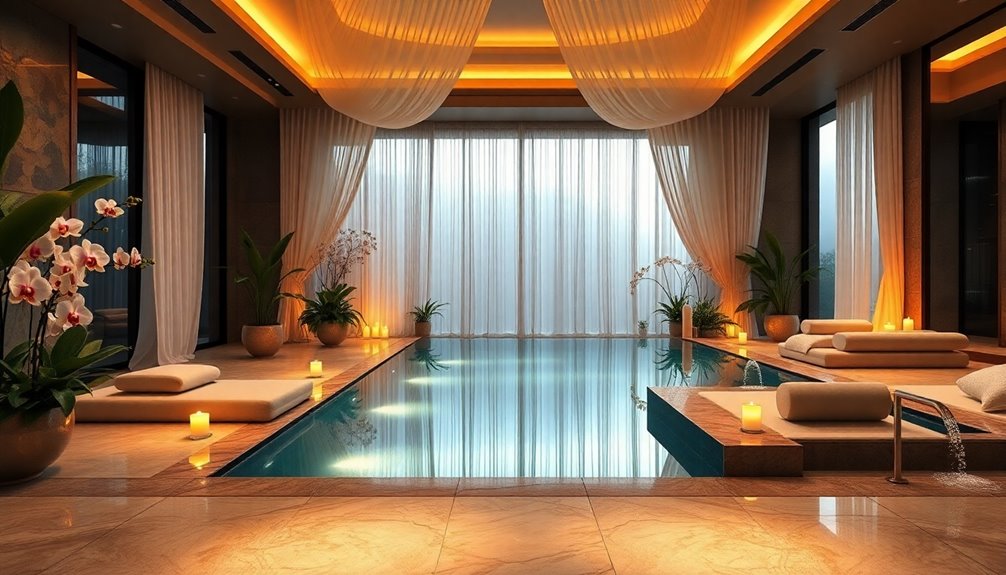Luxury spa design turns spaces into serene retreats, elevating relaxation to new heights. You'll want to focus on earthy color palettes like soft beiges and calming greens, which promote tranquility. Incorporate natural light with large windows and skylights for an airy feel. Use textures such as wood and stone for an organic touch, and don't forget soothing water features like indoor fountains. Create a multi-sensory experience with ambient lighting and calming scents from aromatherapy diffusers. Ultimately, effective design enhances guest satisfaction and drives success. Explore further to uncover more design insights that can help shape your dream spa.
Key Takeaways
- Utilize an earthy color palette with soft beiges and calming greens to create a serene atmosphere for relaxation.
- Incorporate natural light through large windows or skylights to enhance the spa's ambiance and promote a connection to nature.
- Design treatment rooms with privacy and comfort in mind, featuring plush furnishings and ambient lighting to enhance the guest experience.
- Integrate water features like indoor fountains or soaking tubs to provide soothing sounds that elevate relaxation during treatments.
- Emphasize the use of sustainable materials and eco-friendly practices to create a luxurious yet environmentally conscious spa experience.
Essential Features in Spa Room Design
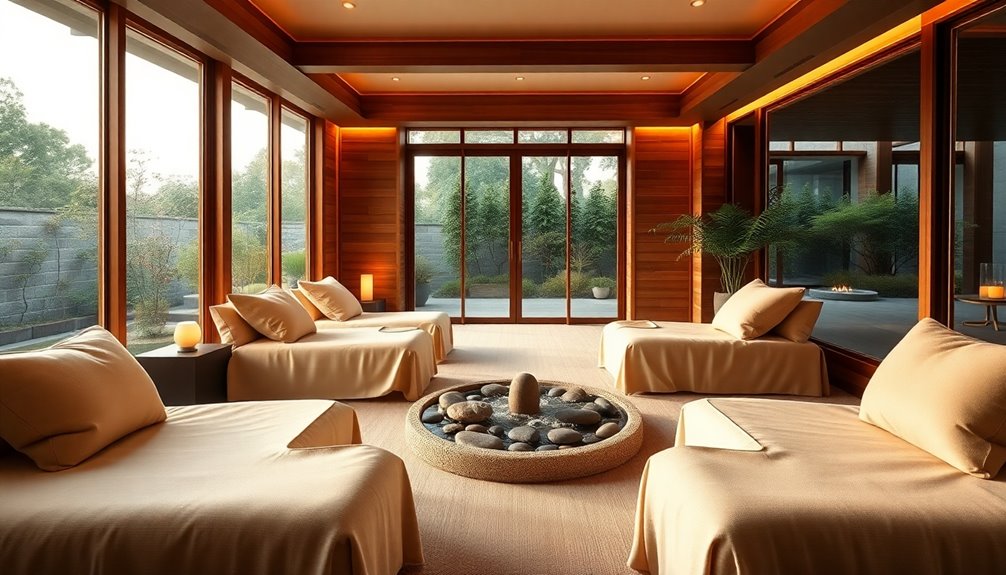
When designing a spa room, it's crucial to consider essential features that enhance relaxation and well-being.
Start with an earthy color palette of soft beiges and calming greens to create a serene atmosphere. Incorporate natural light through skylights or large windows, and use soft, diffused lighting that can adapt to different moods.
Textures matter too; choose natural materials like wood and stone, along with plush furnishings for comfort. Indoor plants can purify the air while adding a touch of nature. Additionally, incorporating natural elements such as water features and plants can significantly enhance the calming atmosphere.
Don't forget water features like soaking tubs or indoor fountains for soothing sounds. Finally, add aromatherapy diffusers with calming scents to complete the tranquil experience, making your spa a true sanctuary for relaxation.
Strategic Spa Layouts and Floor Plans
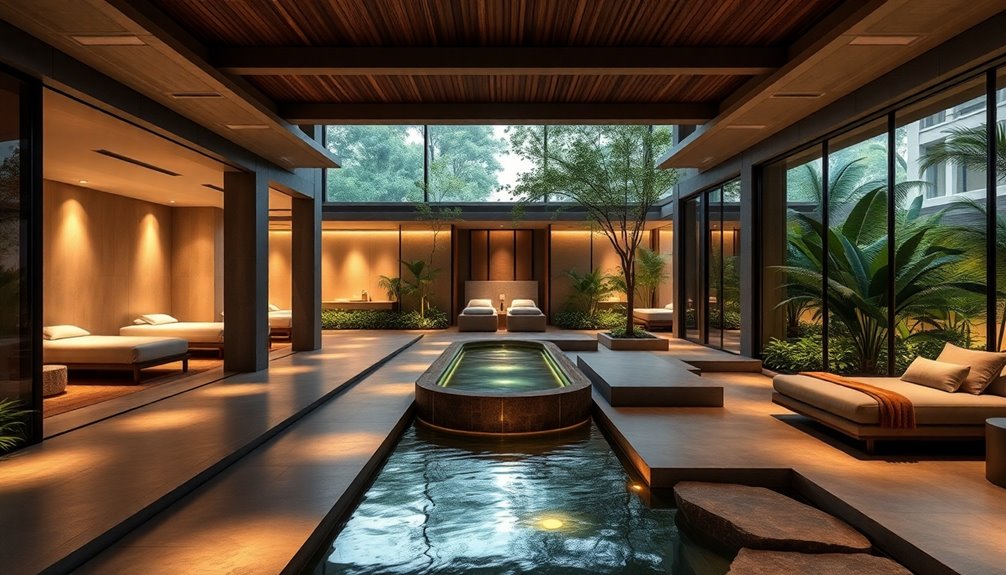
Creating an inviting spa layout is essential for both guest satisfaction and operational efficiency. Start by incorporating organic materials like wood and stone, which foster a cozy ambiance. Use relaxing hues and mood-enhancing lighting to promote tranquility.
Arrange treatment rooms with ample space for privacy and comfort, and include leisure areas, such as waiting rooms, to enhance the guest experience. Additionally, maintaining a cleanliness standard is critical to ensure a positive perception of your spa.
Optimize your layout to minimize unnecessary movement, ensuring easy access for both clients and staff. Plan for future growth by designing adaptable spaces that can accommodate new services or changes.
Lastly, integrate technology like online booking systems to streamline operations, making the entire experience seamless and enjoyable for everyone involved.
Key Elements for Luxurious Design
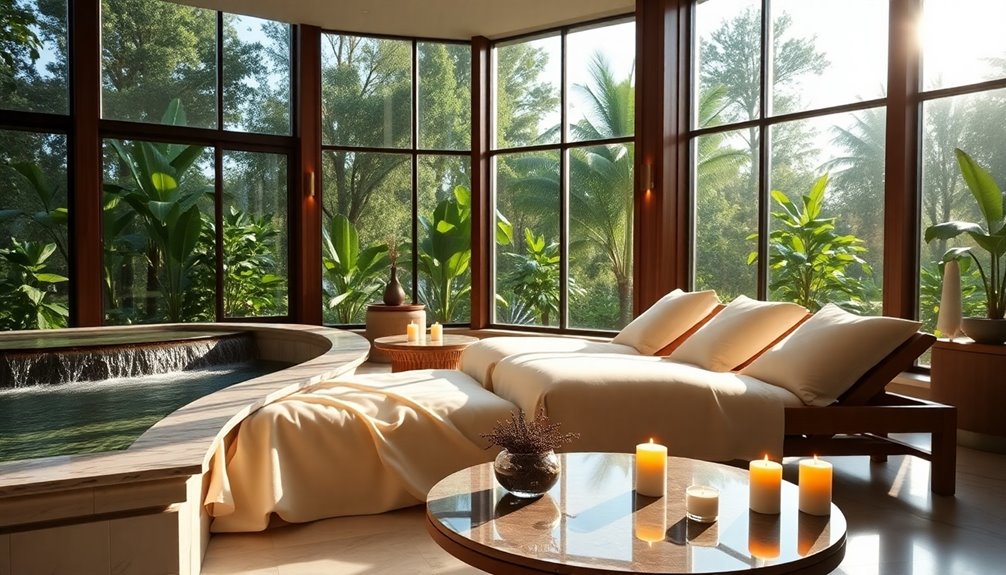
To achieve a truly luxurious spa experience, it's essential to focus on key design elements that elevate both aesthetics and functionality.
Start with an open and airy layout, allowing seamless movement from treatment rooms to relaxation areas while ensuring privacy. Incorporating fluidity in design enhances the user's experience by connecting various spaces harmoniously. Additionally, consider integrating natural materials like wood and stone to bring a touch of warmth and organic beauty into the environment.
Use a neutral color palette, accented with rich tones like emerald or gold, to create a calming yet elegant atmosphere.
Invest in high-end equipment, such as plush treatment beds and state-of-the-art steam rooms, to enhance comfort and provide health benefits.
Finally, prioritize high-quality materials, like velvet upholstery and natural elements, to foster a connection to nature. This blend of luxury and comfort will ensure that every detail contributes to an overall sense of tranquility and indulgence.
This harmonious combination will transform your spa into a luxurious retreat for every guest.
Modern Luxury Spa Design Trends
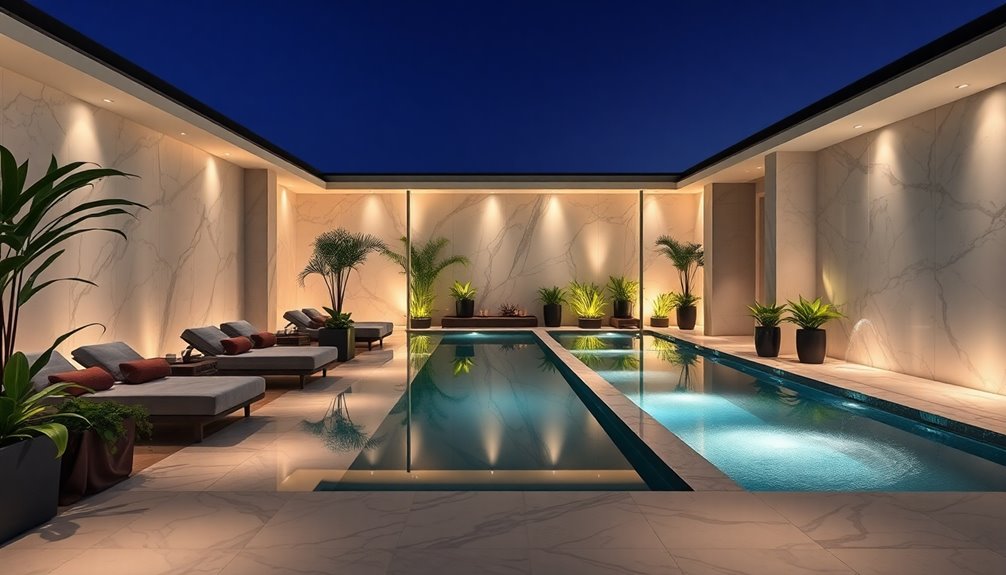
As contemporary spa-goers seek holistic experiences that blend luxury with wellness, modern luxury spa design trends have evolved to meet these expectations.
You'll notice a strong focus on sustainability, using eco-friendly materials like reclaimed wood and energy-efficient systems to minimize environmental impact. Many spas are now emphasizing water conservation techniques to further enhance their commitment to sustainability.
Integration of nature is key, featuring living walls, biophilic designs, and floor-to-ceiling windows that enhance your connection to the outdoors.
Full-stack wellness centers are on the rise, combining fitness, healthy dining, and advanced treatment options all under one roof.
Finally, expect a clean yet cozy design with inviting linens and clever lighting that balances elegance with comfort, ensuring every moment spent in the spa feels luxurious and rejuvenating.
Key Aspects of Hotel Spa Design
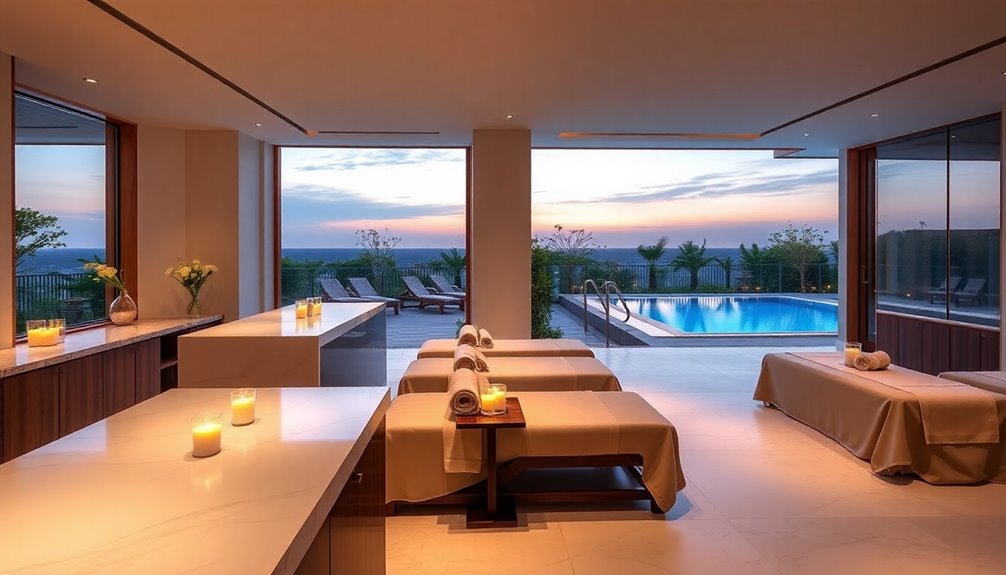
Hotel spa design hinges on a deep understanding of the guest experience, making it essential to define a clear vision and concept that resonates with your target audience.
Start by identifying your guests' demographics and what unique experiences they seek. Establish a unique selling proposition that sets your spa apart, whether through specific treatments or a focus on sustainability.
Next, prioritize space planning. Ensure a welcoming reception area, well-designed treatment rooms, and soothing relaxation spaces. Incorporate sustainability as a core aspect to enhance the appeal of your facility.
Select treatments and equipment that cater to your audience's preferences, from massages to state-of-the-art fitness facilities.
Finally, focus on operational efficiency with smooth traffic flow and natural finishes that create a calming atmosphere, ensuring every detail enhances the overall experience.
Latest Innovations in Spa Features
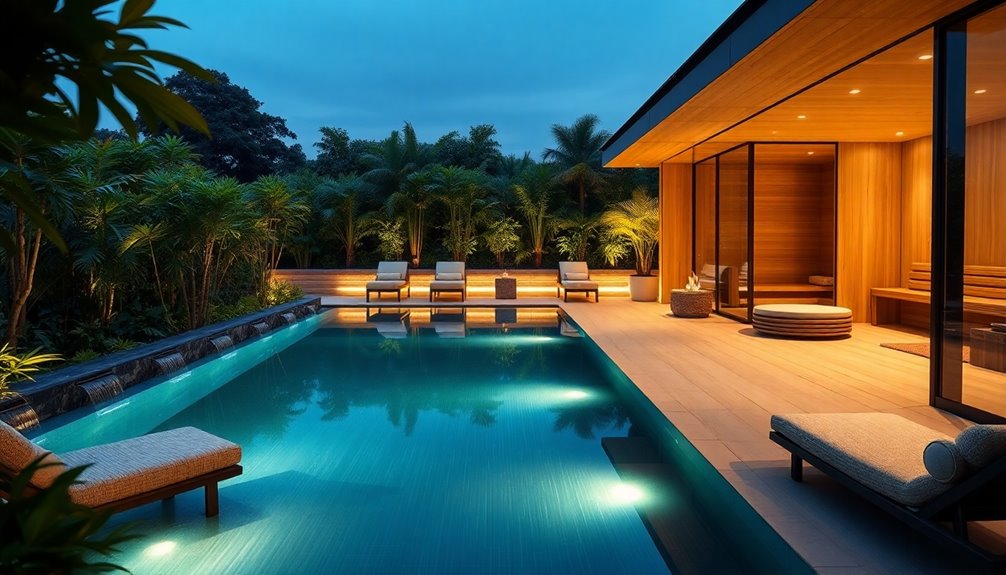
Creating an exceptional spa experience doesn't stop with thoughtful design; integrating the latest innovations in spa features can elevate your offerings to new heights.
Consider incorporating cryotherapy lounges to provide targeted cold therapy, relieving muscle pain and enhancing skin elasticity. Hydrotherapy pools with water jets and customizable settings can improve circulation and relaxation, while chromotherapy enhances mood. The incorporation of wellness innovation through features like these not only attracts guests but also enhances their overall experience.
Meditation pods offer a private sanctuary, combining sound and light for mindfulness. Using natural materials and eco-conscious design not only enriches aesthetics but also promotes sustainability.
Lastly, advanced massage tools and innovative treatment beds enhance therapeutic benefits, allowing you to provide personalized experiences that keep your guests coming back for more.
Embrace these innovations to truly stand out in the spa industry.
Creating a Multi-Sensory Experience
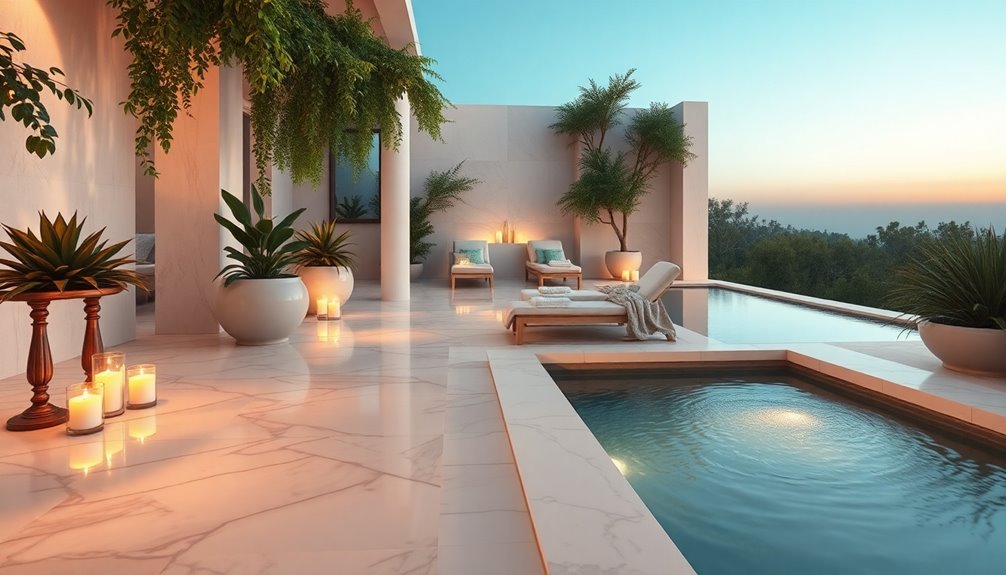
While a tranquil environment is essential for a rejuvenating spa experience, incorporating multi-sensory elements truly transforms the atmosphere.
Start with warm, soft lighting and soothing colors like blue and green to set a calming tone. Nature-inspired artwork and water features enhance the visual appeal.
For auditory stimulation, play gentle instrumental music or nature sounds, creating a serene soundscape.
Engage the sense of smell with essential oils, scented candles, and fresh flowers to fill the air with calming aromas. Utilizing an aroma oil diffuser can further enhance the olfactory experience and promote relaxation.
Ensure tactile comfort with plush seating, heated massage tables, and soft textiles.
Finally, maintain optimal temperature control to keep the environment inviting.
Frequently Asked Questions
What Budget Should I Allocate for Luxury Spa Design?
When you're planning a budget for luxury spa design, consider allocating funds across various categories.
You should expect to spend between $200 to $500 per square foot for construction and design, totaling over $1 million for a larger facility.
Don't forget high-end equipment, which can range from $250,000 to $500,000.
Also, factor in technology systems for better client management, typically costing between $5,000 and $15,000.
Prioritize quality and customization for the best experience.
How Can I Ensure Privacy in Spa Areas?
You wouldn't want the whole neighborhood peeking at your blissful spa retreat!
To ensure privacy, think about physical barriers like wooden fences or elegant enclosures. Natural barriers, like tall hedges or strategic landscaping, can create a lush wall of tranquility.
Don't forget about customizing your space with curtains, screens, and even sound systems to drown out distractions.
With careful planning, you can craft a perfectly secluded sanctuary that feels like paradise!
What Are the Maintenance Requirements for Spa Facilities?
To maintain your spa facilities, you need to follow a structured routine.
Daily tasks include checking drain covers and testing chemical levels.
Weekly, clean the filter and air out the cover.
Monthly, drain and refill the spa, and quarterly, perform deep cleaning and soak filter elements.
Regular inspections play a crucial role in preventative maintenance.
Also, consider using software to track your maintenance efforts and ensure everything runs smoothly and efficiently.
How to Choose a Theme for My Spa Design?
Choosing a theme for your spa design is like crafting a melody; every note must harmonize.
Start by understanding your target audience and defining your brand identity. Consider biophilic elements to bring nature indoors, then select a cohesive theme that immerses clients in a unique experience.
Don't forget to choose a calming aesthetic with luxurious materials and colors.
Finally, gather client feedback to refine your vision and ensure it resonates with them.
What Are Common Mistakes to Avoid in Spa Design?
When designing a spa, you should avoid common mistakes like neglecting your location's natural beauty and not using local materials.
Keep the client journey simple; confusing layouts can hinder relaxation.
Don't prioritize style over substance—ensure materials and drainage are practical.
Remember to create visually appealing spaces for social media.
Lastly, pay attention to details like quality amenities and relaxation areas, as these enhance the overall client experience significantly.
Conclusion
Incorporating these essential elements into your luxury spa design will not only elevate relaxation but also create an oasis that feels like a slice of paradise. By focusing on strategic layouts, modern trends, and innovative features, you can transform any space into a sanctuary that envelops guests in tranquility. Don’t underestimate the power of a multi-sensory experience; it can transport clients to a world where stress melts away like ice in the sun. In addition to these design principles, consider incorporating calming color palettes and natural materials that resonate with the senses, fostering a deeper connection to the environment. This attention to detail can be compared to the experience of being on the oldest cruise ship in service, where nostalgia meets luxury, offering a blend of history and comfort that enchants every guest. By weaving such experiences throughout your spa, you ensure that each visit is not just a treatment, but a journey towards rejuvenation and bliss.
